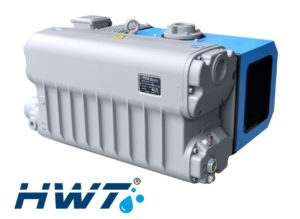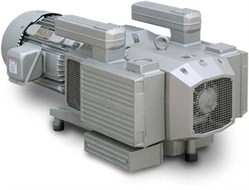If you work in or operate a facility that utilizes rotary vane vacuum pumps, it is in your interest to understand the principle behind how they work.
By its simplest definition, a rotary vane vacuum pump is a type of pump technology that facilitates air compression within a chamber to create a vacuum.
These pumps work using a positive-displacement principle. Rotary vane vacuum pumps consist of a rotor mounted inside a stator or housing. The centrifugal force causes the blades on the rotor to move farther apart to capture the incoming air and expand it in the chamber to create a vacuum.
While these pumps come in a variety of sizes and designs, there are essentially two main categories of rotary vane vacuum pumps: lubricated and dry running. In this article, we will discuss the operating principles of each.
Operating principles of a lubricated rotary vane vacuum pump:
 Rotary vane operation works on the principle of pressure increased by volume reduction. The blades rotate inside the cylinder, and a thin film of oil within the cylinder means that there is practically no wear.
Rotary vane operation works on the principle of pressure increased by volume reduction. The blades rotate inside the cylinder, and a thin film of oil within the cylinder means that there is practically no wear.- Differential pressure within the housing produces the oil lubrication. Pipes between the housings help to accomplish this.
- The rotor is positioned eccentrically inside the housing. Centrifugal force presses the blades against the housing wall, which produces three chambers that capture the air.
- Once the first chamber opens, air passes through the suction flange and into the compressor chamber.
- As the rotor turns, the next blade closes the first chamber and opens the second one. This is the point where the blades are farthest apart and allow for the maximum air volume.
- The mixture of oil and gas is then compressed using volume reduction and then blown into the oil separator housing.
- Some pump designs include outlet valves that prevent the backflow of air once maximum pressure is reached or if the pump is turned off.
- Oil and gas are separated from each other by a process that takes place within the oil separator housing. The oil is diverted into the oil sump. This process is able to take between 95-98% of the oil content out of the air.
- The remaining oil and gas mixture is then put through fine filter elements to remove any remaining oil particles. Later, these particles will be put back into the pump’s oil circuit via a float valve.
- Now that the gas is virtually free of oil, it can be discharged through the air outlet or through pipes or hoses.
Operating principles of dry running rotary vane vacuum pumps
These pumps work on very similar principles to lubricated pumps:
 Just like lubricated pumps, drying running pumps work on the principle of pressure increase by volume reduction.
Just like lubricated pumps, drying running pumps work on the principle of pressure increase by volume reduction.- Dry graphite vanes are used in these pumps, which rub against the surface of the housing cylinder, creating a graphite layer that protects the pump from wear.
- As with their lubricated counterparts, these pumps must also filter the air after it has been compressed to remove any particles and blow them out. Additionally, with this type of pump, air is usually put through a cooler to reduce the temperature of the exhaust.
Contact PFS Pumps today
If you require installation or maintenance of your rotary vane vacuum pumps, we can help. Contact us today to speak with a member of our team.
